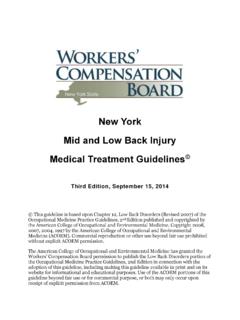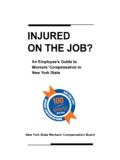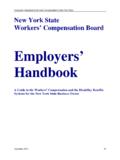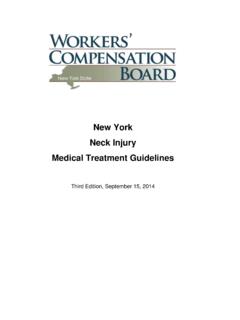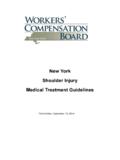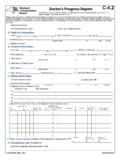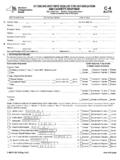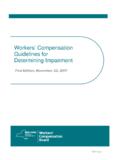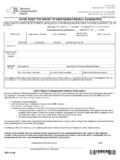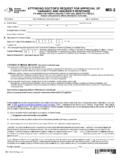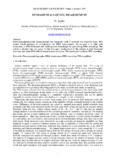Transcription of New York Mid and Low Back Injury Medical …
1 New York Mid and Low back Injury Medical treatment guidelines . second edition January 14, 2013. Corrected February 22, 2013. Effective March 1, 2013. This guideline is based upon Chapter 12, Low back Disorders (Revised 2007) of the Occupational Medicine Practice guidelines , 2nd edition published and copyrighted by the American College of Occupational and Environmental Medicine. Copyright 2008, 2007, 2004, 1997 by the American College of Occupational and Environmental Medicine (ACOEM). Commercial reproduction or other use beyond fair use prohibited without explicit ACOEM permission. The American College of Occupational and Environmental Medicine has granted the Workers'. Compensation Board permission to publish the Low back Disorders portion of the Occupational Medicine Practice guidelines , 2nd edition in connection with the adoption of this guideline, including making this guideline available in print and on its website for informational and educational purposes. Use of the ACOEM portions of this guideline beyond fair use or for commercial purpose, or both may only occur upon receipt of explicit permission from ACOEM.
2 New York State Workers' Compensation Board New York Mid and Low back Injury Medical treatment guidelines TABLE OF CONTENTS. A GENERAL GUIDELINE PRINCIPLES .. 1. Medical CARE .. 1. RENDERING OF Medical SERVICES .. 1. POSITIVE PATIENT RESPONSE .. 1. RE-EVALUATE treatment .. 1. EDUCATION .. 1. DIAGNOSTIC TIME FRAMES .. 2. treatment TIME FRAMES .. 2. SIX-MONTH TIME FRAME .. 2. DELAYED RECOVERY .. 2. ACTIVE 2. ACTIVE THERAPEUTIC EXERCISE PROGRAM .. 3. DIAGNOSTIC IMAGING AND TESTING PROCEDURES .. 3. SURGICAL INTERVENTIONS .. 3. 4. PERSONALITY/PSYCHOLOGICAL/PSYCHOSOCIAL EVALUATIONS .. 4. PERSONALITY/PSYCHOLOGICAL/PSYCHOSOCIAL INTERVENTION .. 5. FUNCTIONAL CAPACITY EVALUATION (FCE) (14) .. 5. RETURN TO WORK .. 6. JOB SITE EVALUATION .. 6. GUIDELINE RECOMMENDATIONS AND Medical EVIDENCE .. 7. EXPERIMENTAL treatment .. 7. INJURED WORKERS AS PATIENTS .. 7. SCOPE OF PRACTICE .. 7. second edition , January 14, 2013 i New York State Workers' Compensation Board New York Mid and Low back Injury Medical treatment guidelines B INTRODUCTION.
3 7. HISTORY TAKING AND PHYSICAL EXAMINATION .. 7. History of Present Illness .. 7. Past History .. 8. Physical Examination .. 9. Spinal Cord Evaluation .. 9. Relationship to Work .. 10. Red Flags .. 10. IMAGING/ANATOMICAL TESTS .. 11. LABORATORY TESTING .. 11. Complete Blood Count (CBC) .. 11. Rheumatalogic, Infection or Connective Tissue Disorder .. 11. Metabolic Bone Disease .. 11. Liver and Kidney 12. FOLLOW-UP DIAGNOSTIC IMAGING AND TESTING PROCEDURES .. 12. C DIAGNOSTIC STUDIES .. 13. IMAGING STUDIES .. 13. Roentgenograms (X-Rays) .. 13. Magnetic Resonance Imaging (MRI) .. 14. Computerized Tomography (CT) .. 15. Myelography (Including CT Myelography and MRI Myelography) .. 16. Bone Scans .. 16. Fluoroscopy ..17. Single Proton Emission Computed Tomography (SPECT) ..17. Ultrasound (Diagnostic) ..17. second edition , January 14, 2013 ii New York State Workers' Compensation Board New York Mid and Low back Injury Medical treatment guidelines Videofluoroscopy ..17. OTHER TESTS/PROCEDURES.
4 18. Electrodiagnostic Studies (EDS)-includes Needle EMG's (Electromyogram) .. 18. Surface Electromyography (Surface EMG).. 19. Diagnostic Facet Blocks .. 19. Lumbar Discography .. 19. CT/MRI Discography .. 19. Myeloscopy .. 19. Thermography .. 20. D THERAPEUTIC PROCEDURES-NON-OPERATIVE .. 20. ACUPUNTURE .. 20. APPLIANCES .. 22. Shoe Insoles and Shoe Lifts .. 22. Kinesiotaping, Taping or Strapping .. 22. Lumbar Supports .. 22. Magnets .. 22. Mattresses, Water Beds, and Sleeping Surfaces (None with Sciatica) . 23. BED REST .. 23. BIOFEEDBACK .. 24. ELECTRICAL THERAPIES .. 24. Interferential Therapy .. 24. Transcutaneous Electrical Neurostimulation (TENS).. 25. Percutaneous Electrical Nerve Stimulation (PENS) .. 25. Microcurrent Electrical Stimulation .. 26. Electrical Nerve Block .. 26. second edition , January 14, 2013 iii New York State Workers' Compensation Board New York Mid and Low back Injury Medical treatment guidelines Electrical Stimulation (Unattended).. 26.
5 Transcutaneous Neurostimulator (TCNS) .. 26. H-Wave 26. High-Voltage Galvanic .. 26. 27. INJECTION THERAPIES .. 27. Lumbar/Transforaminal/Epidural Injections .. 27. Intradiscal Steroids .. 30. Chemonucleolysis (Chymopapain and Collagenase) .. 30. Tender and Trigger Point Injections .. 30. Diagnostic Facet Joint Injections (Intra-articular and Nerve Blocks) . 31. Therapeutic Facet Joint Injections .. 31. Facet Joint Hyaluronic Acid Injections .. 32. Sacroiliac Joint Injections .. 32. Prolotherapy Injections .. 33. Platelet Rich Plasma (PRP) .. 33. MEDICATIONS .. 33. Acetaminophen .. 33. Anti-Depressants .. 34. Anti-Seizure Drugs .. 35. Colchicine (Oral and IV Colchicine) .. 36. Complementary and Alternative 36. Other creams and 38. Vitamins .. 38. Non-Steroidal Anti-Inflammatory Drugs (NSAIDs) .. 38. second edition , January 14, 2013 iv New York State Workers' Compensation Board New York Mid and Low back Injury Medical treatment guidelines Opioids Oral, Transdermal, and Parenteral.
6 40. Skeletal Muscle Relaxants .. 42. Systemic Glucocorticosteroids (aka Steroids ) .. 44. Tramadol .. 44. Tumor Necrosis Factor- Inhibitors .. 45. SLEEP POSTURE .. 45. THERAPY: ACTIVE .. 46. Therapeutic Exercise .. 46. Aerobic Exercises .. 46. Strengthening and Stabilization Exercises .. 48. Aquatic Therapy (Including Swimming) .. 49. MEDX Machine .. 49. Yoga .. 50. THERAPY: PASSIVE .. 50. Manipulation .. 50. Manipulation under Anesthesia (MUA) and Medication-Assisted Spinal Manipulation (MASM) .. 51. Massage (Manual or Mechanical) .. 51. Mobilization (Joint) .. 53. Mobilization (Soft Tissue) .. 53. Superficial Heat and Cold .. 54. Diathermy .. 54. Infrared Therapy .. 54. Ultrasound .. 55. Low Level Laser Therapy .. 55. Myofascial Release .. 55. second edition , January 14, 2013 v New York State Workers' Compensation Board New York Mid and Low back Injury Medical treatment guidelines 55. Reflexology .. 55. Traction .. 56. Vertebral Axial Compression (VAX-D) and Other Decompressive Devices.
7 56. THERAPY: ONGOING MAINTENANCE CARE .. 56. RADIOFREQUENCY NEUROTOMY, NEUROTOMY, AND FACET. RHIZOTOMY .. 57. Radiofrequency Neurotomy, Neurotomy, and Facet Rhizotomy .. 57. Dorsal Root Ganglia Radiofrequency Lesioning .. 57. Intradiscal Electrothermal Therapy (IDET) .. 58. Percutaneous Intradiscal Radiofrequency Thermocoagulation (PIRFT).. 58. E THERAPEUTIC PROCEDURES: OPERATIVE .. 58. Discectomy, Microdiscectomy, Sequestrectomy, Endoscopic Decompression .. 58. 59. DECOMPRESSIVE SURGERY (LAMINOTOMY/FACETECTOMY, LAMINECTOMY) .. 59. SPINAL FUSION .. 60. ELECTRICAL BONE GROWTH STIMULATORS .. 61. DISC REPLACEMENT .. 62. VERTEBROPLASTY AND KYPHOPLASTY .. 64. SACROILIAC SURGERY .. 64. INTRAOPERATIVE MONITORING .. 64. IMPLANTABLE SPINAL CORD STIMULATORS .. 65. second edition , January 14, 2013 vi A GENERAL GUIDELINE PRINCIPLES. The principles summarized in this section are key to the intended application of the New York State Medical treatment guidelines . Medical Care Medical CARE.
8 Medical care and treatment required as a result of a work-related Injury should be focused on restoring functional ability required to meet the patient's daily and work activities and return to work, while striving to restore the patient's health to its pre- Injury status in so far as is feasible. RENDERING OF Medical SERVICES. Any Medical provider rendering services to a workers compensation patient must utilize the treatment guidelines as provided for with respect to all work-related injuries and or illnesses. POSITIVE PATIENT RESPONSE. Positive results are defined primarily as functional gains which can be objectively measured. Objective functional gains include, but are not limited to, positional tolerances, range of motion, strength, endurance, activities of daily living, cognition, psychological behavior, and efficiency/velocity measures which can be quantified. Subjective reports of pain and function should be considered and given relative weight when the pain has anatomic and physiologic correlation.
9 RE-EVALUATE treatment . If a given treatment or modality is not producing positive results, the provider should either modify or discontinue the treatment regime. The provider should evaluate the efficacy of the treatment or modality 2 to 3. weeks after the initial visit and 3 to 4 weeks thereafter. Reconsideration of diagnosis should also occur in the event of poor response to a rational intervention. Education EDUCATION. Education of the patient and family, as well as the employer, insurer, policy makers and the community should be a primary emphasis in the treatment of work-related Injury or illness. Practitioners must develop second edition , January 14, 2013 1. New York State Workers' Compensation Board New York Mid and Low back Injury Medical treatment guidelines and implement effective educational strategies and skills. An education- based paradigm should always start with communication providing reassuring information to the patient. No treatment plan is complete without addressing issues of individual and/or group patient education as a means of facilitating self-management of symptoms and prevention of future Injury .
10 Time Frames DIAGNOSTIC TIME FRAMES. Diagnostic time frames for conducting diagnostic testing commence on the date of Injury . Clinical judgment may substantiate the need to accelerate or decelerate the time frames discussed in this document. treatment TIME FRAMES. treatment time frames for specific interventions commence once treatments have been initiated, not on the date of Injury . Obviously, duration may be impacted by disease process and severity, patient compliance, as well as availability of services. Clinical judgment may substantiate the need to accelerate or decelerate the time frames discussed in this document. SIX-MONTH TIME FRAME. Since the prognosis drops precipitously for returning an injured worker to work once he/she has been temporarily totally disabled for more than six months, the emphasis within these guidelines is to move patients along a continuum of care and return to work within a six-month time frame, whenever possible. DELAYED RECOVERY. For those patients who are failing to make expected progress 6-12 weeks after an Injury , reexamination in order to confirm the accuracy of the diagnosis should be made.
